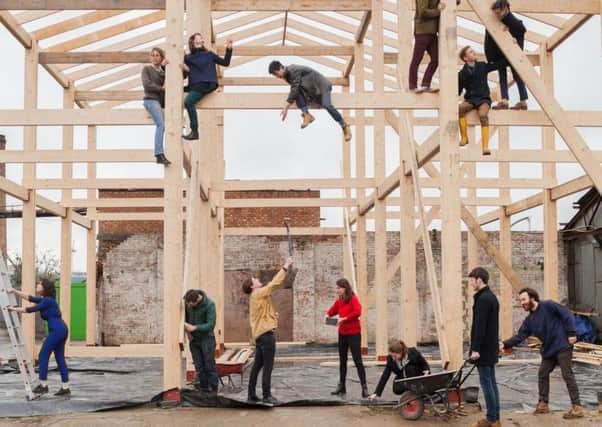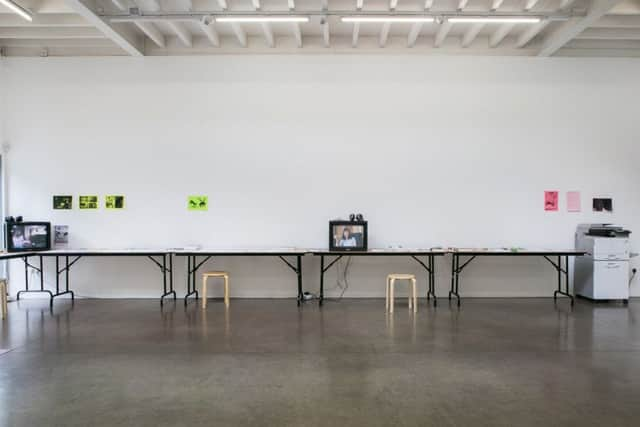The Turner Prize comes to Glasgow


IN AUGUST 1991 Ross Sinclair, then a young artist who left a rock band to go to art school, wrote a polemical essay entitled Bad Smells But No Sign Of The Corpse. At its core was the contention that artists shouldn’t wait to be discovered, didn’t need to travel to London to work and should just get on with it themselves. Sinclair was just one of dozens of Glasgow School of Art graduates setting up their own exhibitions and making work for artist-led galleries. “Doors lie open all over the world,” the essay concludes, “all it takes is for us to go through them.”
This week, as the Turner Prize 2015 exhibition opens at Tramway, Sinclair’s neon art works are hanging on the façade of the city’s Gallery of Modern Art and London has once more come knocking on Glasgow’s door. The prize, established in 1984, is awarded to a British artist under 50 for outstanding work. These days, every second year, the exhibition leaves the confines of Tate Britain in London. It was held in Gateshead in 2011 and Derry in 2013.
Advertisement
Hide AdAdvertisement
Hide AdThis year the nominees, Bonnie Camplin, Janice Kerbel, Nicole Wermers and the architecture and design collective Assemble, are all London-based. But in the past 20 years the city of Glasgow, and in particular the alumni of Glasgow School of Art, have dominated Turner Prize shortlists.


Glasgow winners include Douglas Gordon (1996), Simon Starling (2005), Richard Wright (2009), Martin Boyce (2011) and Duncan Campbell (2014). Scots Martin Creed (2001) and Susan Philipsz (2010) made their careers elsewhere, but grew up in or near the city. Nominees Christine Borland, Jim Lambie, Nathan Coley, Cathy Wilkes, Lucy Skaer, Karla Black, Luke Fowler, David Shrigley, Ciara Philips and Tris Vonna-Michell have all studied or worked in Glasgow.
Sarah Munro, head of art at Glasgow Life and director of Tramway, which will host the 2015 prize, says: “There’s such a strong artistic community in Glasgow. You often see that peak with a particular generation of artists, but in Glasgow it has been sustained and evolved over a far longer period.”
Art isn’t made by cities or by institutions, but key factors can be observed in Glasgow’s cultural strength. One is Glasgow School of Art, not just the glorious Mackintosh building currently rising from the ashes, but its grotty peripheries. It was in the grim Girls High building that the Environmental Art course founded by David Harding in 1985 took root, nurturing the generation of artists that included Gordon, Sinclair, Borland and Boyce. Another potent symbol is the River Clyde: the legacy of shipbuilding and heavy industry has provided the city with a particular fabric. Glasgow’s studio and production facilities are unrivalled and it is where public support has been most effective. Glasgow’s art scene emerged in the economic doldrums of the late Thatcher era, and there were empty shops, former workshops and factories as well as fine tenement flats for artists to live in and show their work. Glasgow’s Victorian architecture, its arts and crafts heritage and its failed post-war architecture has had a direct impact on many artists who are fascinated with the legacies of design or the ideas of craft and making.
Art dealer Toby Webster describes Glasgow’s historic innovations in industry and the arts, saying: “We were left with the shell of all of that.” Raised in the city’s West End, he learned from the example of his grandfather, a stained glass artist who had his studio at home. Webster studied in the Environmental Art department and cut his curatorial teeth at the artist-led gallery Transmission. His commercial gallery, The Modern Institute, represents many of his own generation who have stayed in the city while forging international careers. “It was just about investing in the artists and they have grown.”
If, at times, the gap between Webster’s position at the top of the international art world and that of the struggling artists in the city is rather pointed, the scale and quality of his operation is world class. One can’t help feel that if he were in another field, engineering perhaps, the city and the government would be hanging on his every word. “I love Glasgow,” he says. “It’s amazing. It deserves so much better than the hand it has been dealt. It requires and deserves so much investment.”
Katrina Brown, director of the Common Guild, commissioned Janice Kerbel’s artwork, an ensemble performance entitled Doug, which has been nominated for this year’s prize. “It’s always heartening to see the work recognised on an international stage,” she says. “Artists invest so much in exhibitions that can seem like very fleeting things, but this helps to make them more permanent.”
Despite its international reach, the Common Guild is a small-scale operation that has been loaned its home in the lofty Park district by Turner Prize-wining artist Douglas Gordon.
Advertisement
Hide AdAdvertisement
Hide AdWebster says that Glasgow’s success “is held together by people who are willing to do something for nothing”. The new generation of those personalities includes Ellie Royle and Max Slaven, whose David Dale Gallery runs a brilliant programme in an industrial backstreet in Bridgeton, or tenletters, a project run out of a Govanhill flat by artists Scott Rogers, Sarah Rose and Rebecca Wilcox.
What will be the impact of the Turner Prize 2015 exhibition? For Sarah Munro, it’s about the reach of a new education programme and the wider pubic recognition it gives to the venue’s existing work. “The Turner is such a powerful public brand, you become visible, she says. “A much broader public is aware of what you do.”
Declan Long, lecturer at the National College of Art and Design in Dublin, was a judge of the 2013 prize in Derry. On that occasion the Ebrington Barracks, once the heart of British military power in the city, were reborn as a gallery space. But the building is now office spaces. Long says that despite these failings the Turner is “a process not a party”. There were some good legacies, even if these didn’t come about “in the grand public way that the politicians would have liked”.
In Glasgow, the city’s infrastructure is shoogly, but its artists are steadfast. Its art scene, says Long, “doesn’t need the endorsement of the prize... it’s the best place in the UK to develop a career as an artist, or indeed to observe the careers of artists. It has an atmosphere of encouragement, conviviality and criticality that you just don’t get anywhere else.”
• The Turner Prize Exhibition opens at Glsagow’s Tramway tomorrow and runs until 17 January